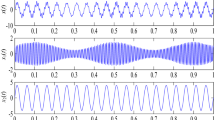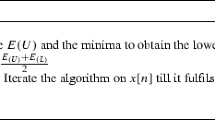Abstract
A new algorithm, named segmented second empirical mode decomposition (EMD) algorithm, is proposed in this paper in order to reduce the computing time of EMD and make EMD algorithm available to online time-frequency analysis. The original data is divided into some segments with the same length. Each segment data is processed based on the principle of the first-level EMD decomposition. The algorithm is compared with the traditional EMD and results show that it is more useful and effective for analyzing nonlinear and non-stationary signals.
Similar content being viewed by others
References
Huang N E, Shen Z, Long R S, et al. The empirical mode decomposition and the Hilbert spectrum for nonlinear and non-stationary time series analysis [J]. Proceeding of The Royal Society of London, 1998, A454(4): 903–995.
Huang N E, Shen Z, Long R S. A new view of nonlinear water waves-Hilbert spectrum [J]. Annual Review of Fluid Mechanics, 1999, 31: 417–457.
Cheng J S, Yu D J, Yang Y. The application of energy operator demodulation approach based on EMD in machinery fault diagnosis [J]. Mechanical Systems and Signal Processing, 2007, 21(2): 668–677.
Li H L, Deng X Y, Dai H L. Structural damage detection using the combination method of EMD and wavelet analysis [J]. Mechanical Systems and Signal Processing, 2007, 21(1): 298–306.
Cheng J S, Yu D J, Yang Y. A fault diagnosis approach for roller bearings based on EMD method and AR model [J]. Mechanical Systems and Signal Processing, 2006, 20(2): 350–362.
Zhang J, Shen M F, Song J. A study of using three time-frequency methods in the analysis of heart sound signals [J]. Journal of Shantou University (Natural Science Edition), 2003, 18(2): 62–69 (in Chinese).
Shi C X, Luo Q F. Hilbert-Huang transform and wavelet analysis of time history signal [J]. Acta Seismologica Sinica, 2003, 16(7): 422–429.
Qu W Z, Zeng Y L, Jiang Y J, et al. High-speed rotor vibration signal analysis using an improved EMD method [J]. Mechanical Science and Technology, 2006, 25(10): 1166–1169.
Hu X, Wang Z Z, Ren X M. A method of modified empirical mode decomposition method [J]. Signal Processing, 2006, 22(4): 564–567.
Hu J S, Yang S X. Study on valid-data-based EMD fast algorithm [J]. Journal of Vibration, Measurement and Diagnosis, 2006, 26(2): 119–122.
Mao W, Jin R H, Geng J P, et al. A time-frequency analysis method for non-stationary signals based on improved Hilbert-Huang transform and its application [J]. Journal of Shanghai Jiaotong University, 2006, 40(5):724–729 (in Chinese).
Schlurmann T. Spectral analysis of nonlinear water waves based on the Hilbert-Huang transformation [J]. Journal of Offshore Mechanics and Arctic Engineering, 2002, 124(2): 22–27.
Author information
Authors and Affiliations
Corresponding author
About this article
Cite this article
Zhang, Mc., Zhu, Ky. & Li, Cx. Segmented second algorithm of empirical mode decomposition. J. Shanghai Univ.(Engl. Ed.) 12, 444–449 (2008). https://doi.org/10.1007/s11741-008-0513-2
Received:
Published:
Issue Date:
DOI: https://doi.org/10.1007/s11741-008-0513-2




